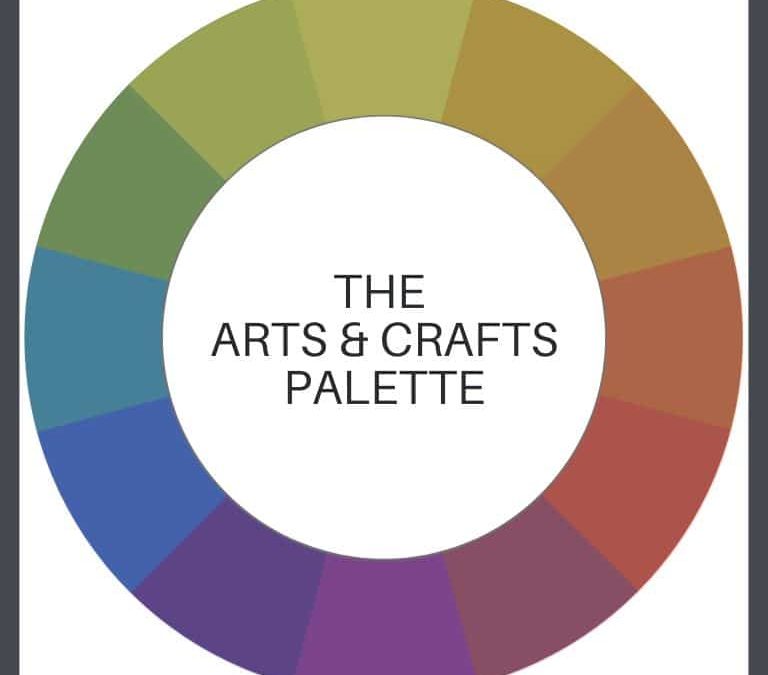
by bungalow101 | May 24, 2022 | Paint
HARMONY
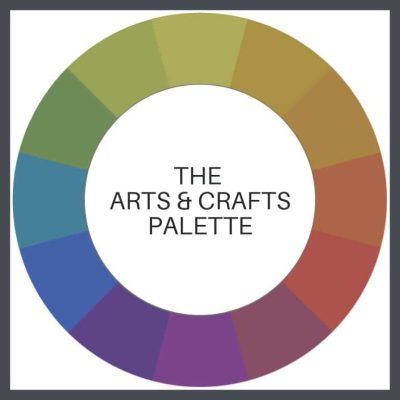 Bungalow color harmony begins with being familiar with your home’s long philosophical & aesthetic history. Your beloved bungalow is the offspring of a movement that started in the late 1800’s in England & spread to the United States, primarily through the work & words of Gustav Stickley, a furniture designer & maker as well as a publisher.
Bungalow color harmony begins with being familiar with your home’s long philosophical & aesthetic history. Your beloved bungalow is the offspring of a movement that started in the late 1800’s in England & spread to the United States, primarily through the work & words of Gustav Stickley, a furniture designer & maker as well as a publisher.
His statement that, “The quiet rhythmic monotone of the wall of logs fills one with the rustic peace of a secluded nook in the woods,” reflects the ideals of the early British Arts & Crafts founders while making it purely American. Stickley inspired the popularity of this design philosophy in the United States through his furniture designs, then his magazine, his architecture.
He even had a farm where he grew food for his restaurant! Stickley was a man with a vision 100 years ahead of his time inspiring not 1 but 2 Arts & Crafts Revivals. I was a nature loving, embroidering hippy in the 60’s & here I am again promoting the vision 50 years later!
Anyway….
BUNGALOW COLOR HARMONY DEFINED
The basis of any design in which pleasing color relationships are used to convey a message & create a particular look or feel.
These eye-pleasing combinations are based on different geometric relationships on the color wheel. They can be moved around the color wheel to get different combinations.
Monochromatic
A color scheme using one color or several colors close to it. This color combination can be very soothing and calming. Maybe not in purple!
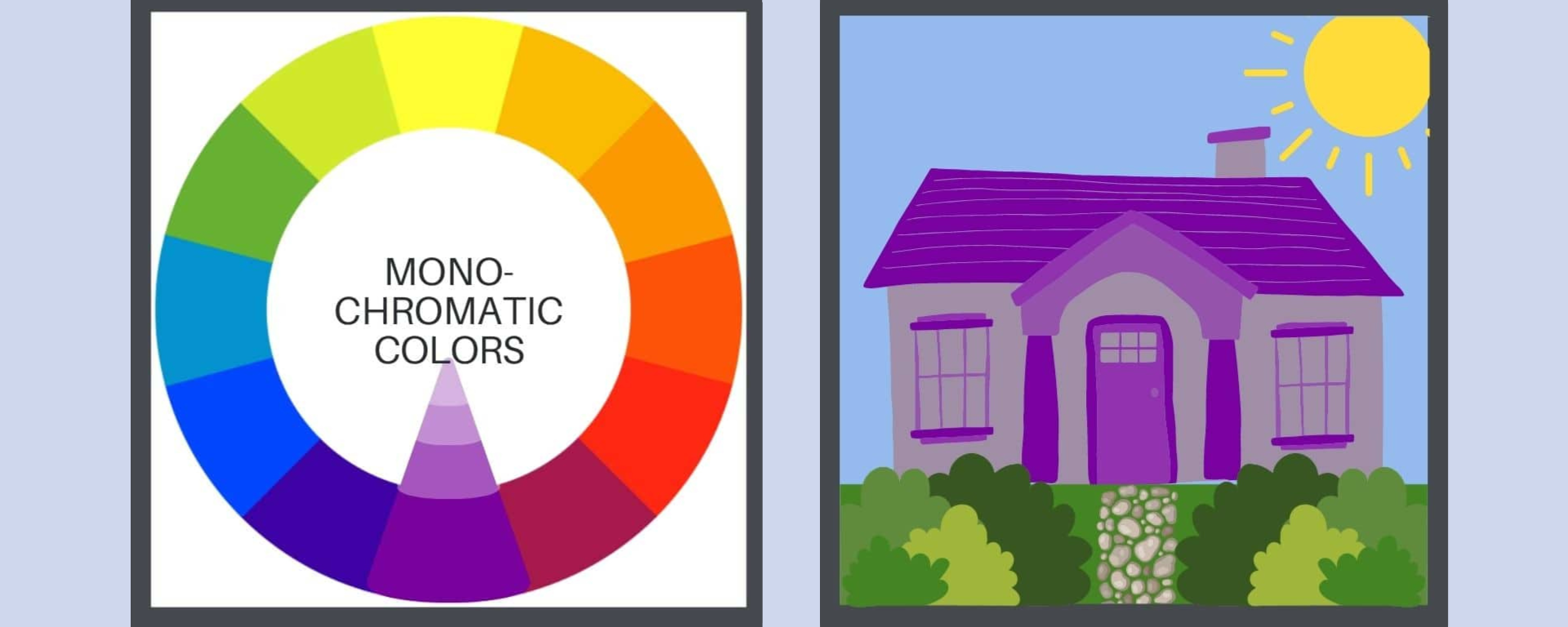
Complementary
Two colors that are opposite each other on the color wheel (example: red and green.) Complementaries can make each other appear brighter. Green next to red makes the red look “redder” & vice versa.
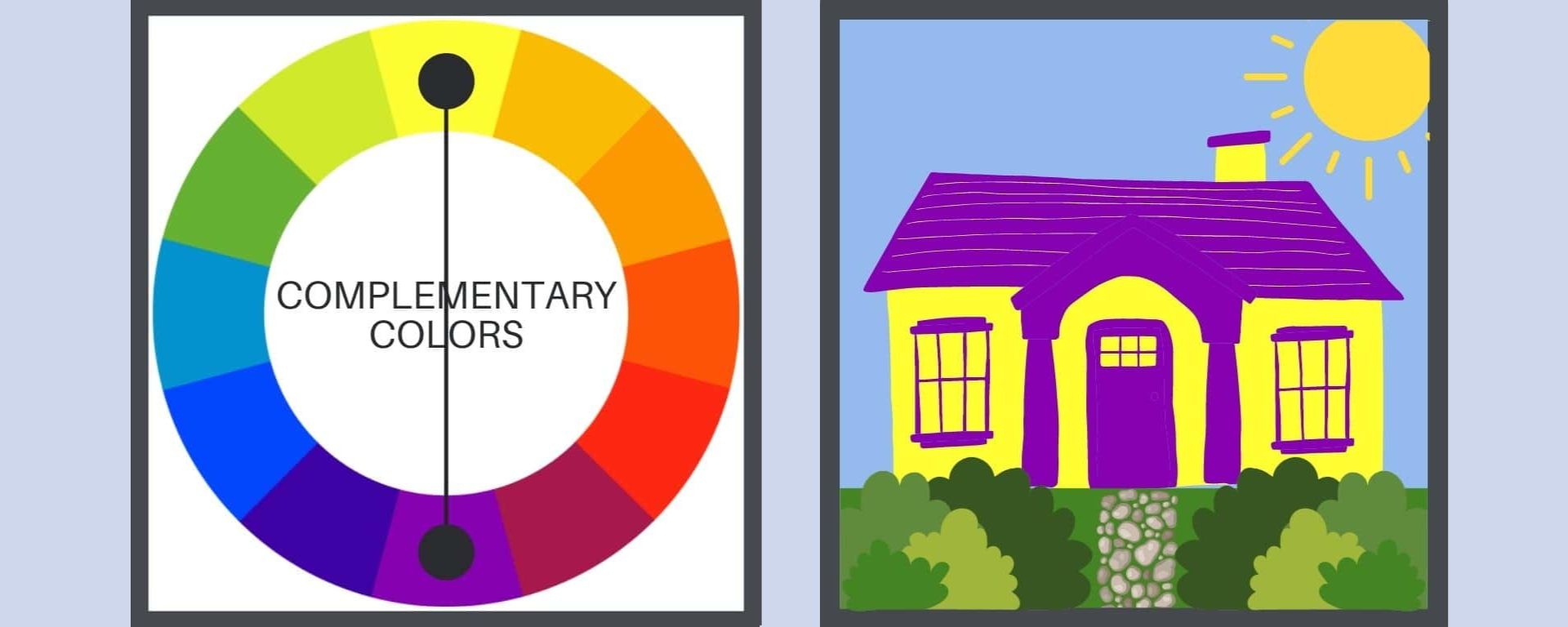
Split complementary
A split-complementary color scheme takes up a primary color & two secondary colors. Here are some examples of how these colors would look on a little cartoon bungalow. Uh, yeah.

Analogous
Any three colors side-by-side on the color wheel. Analogous colors are often found in nature and can be very pleasing to the eye. Usually, one color is more dominant than the others. The one pictured is not a bad combo- maybe with some tweaking.
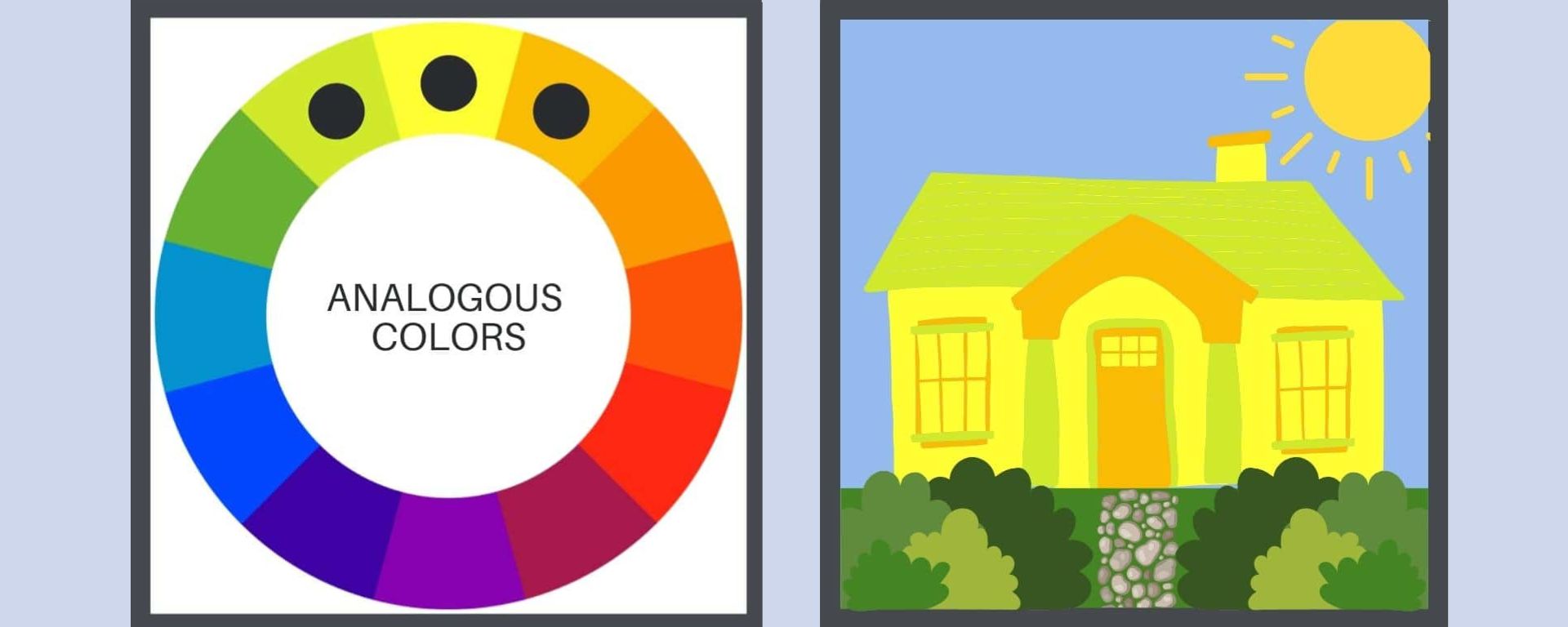
Triadic
Three colors that are equidistant from each other on the color wheel (example: the primary colors, red, yellow and blue.) Think alphabet blocks.
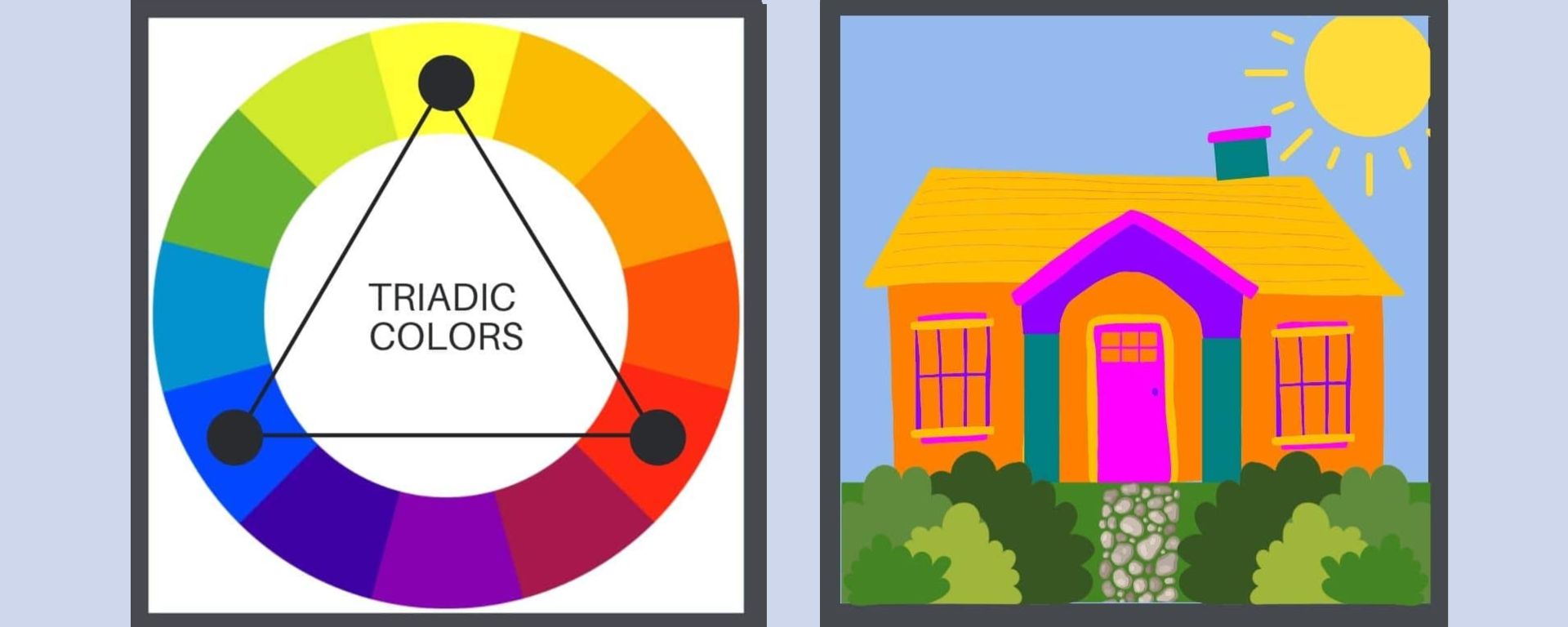
Tetradic
Four colors that form a rectangle from each other on the color wheel. I’m not fond of more than 3 colors on a bungalow. It’s no more appropriate than adding gingerbread to the front gable.

And more examples. So far, not so good. Let’s find out why!
BUNGALOW COLOR HARMONY- MANIPULATING COLOR
Tints
Adding white to colors.
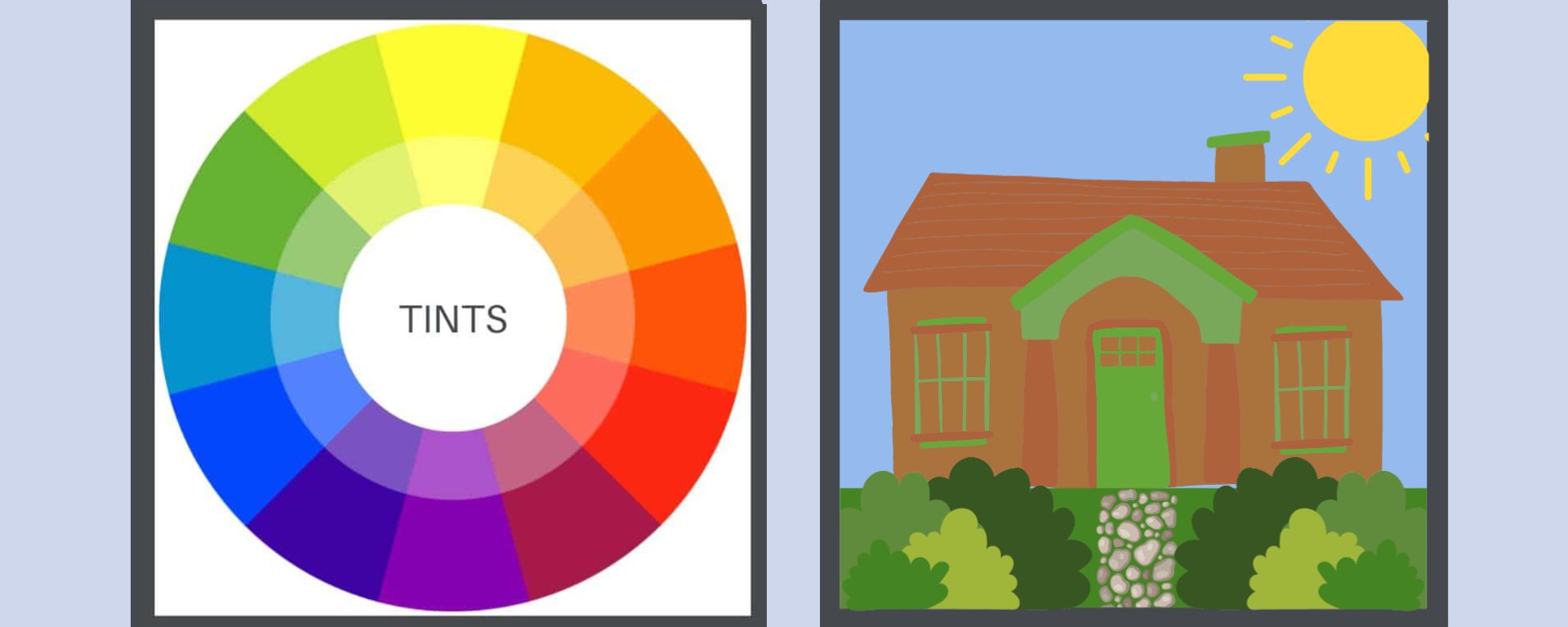
Shades
Adding black to a pure hue. So close!
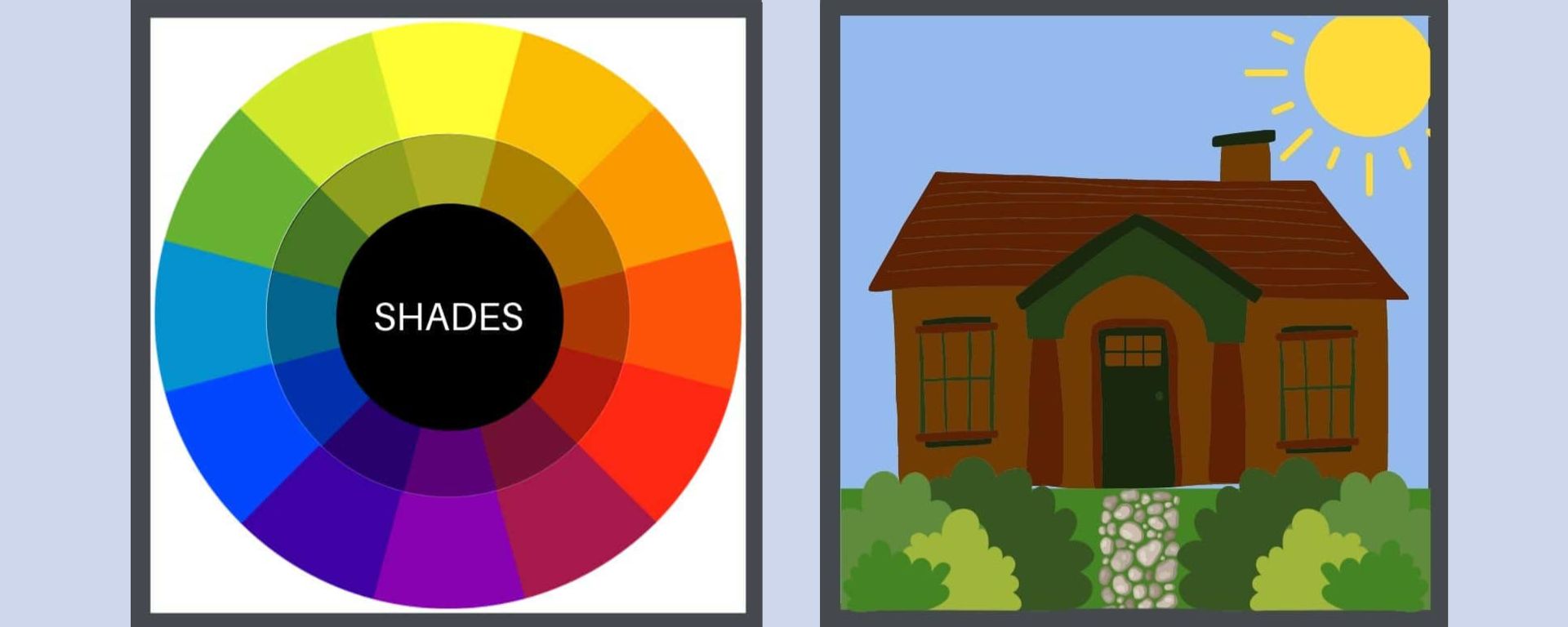
Tones
Requires adding both black & white. The resulting colors are more natural than shades and tints & pure color. Ah-ha!
Let’s see how they do on the little houses.
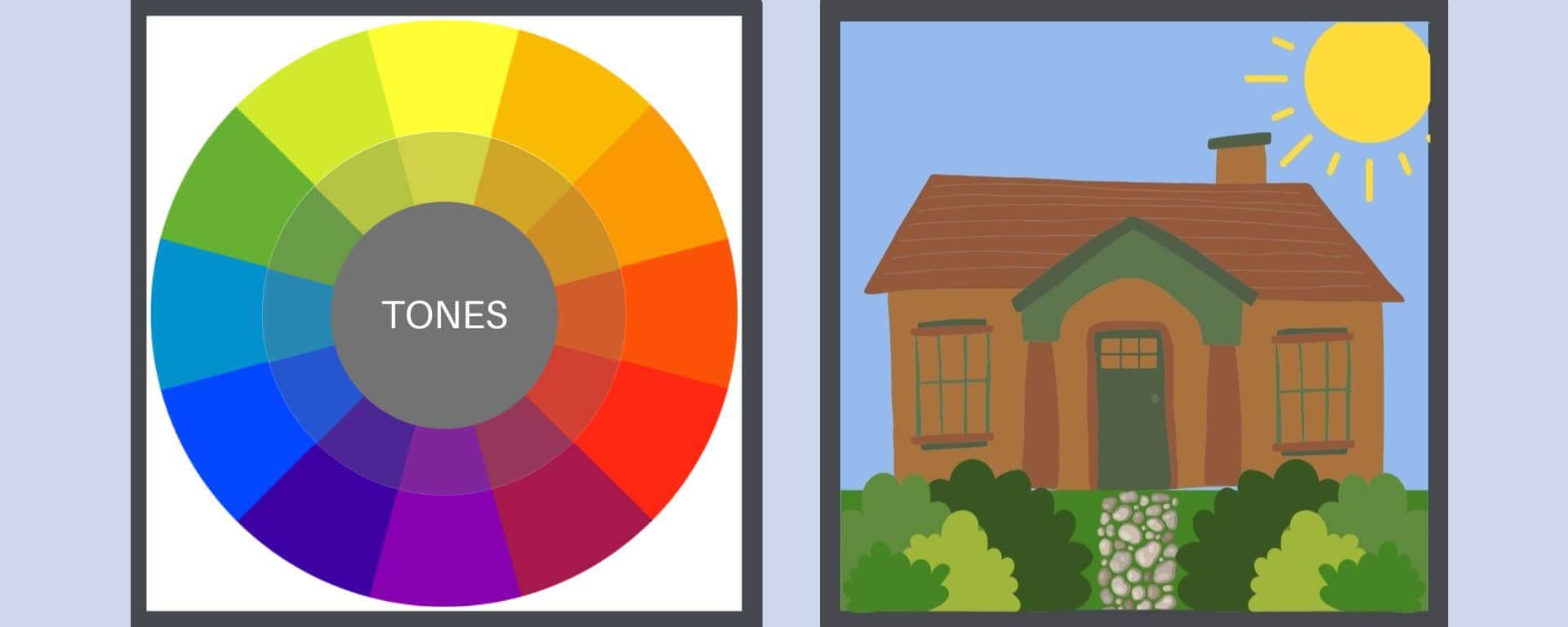
Value
The relative lightness or darkness of a color, which is held constant. A paint color sample strip, showing a color from lighter to darker, is a perfect example of changing value.

We are so-o-o-o much closer, but, there’s more! We’re going for the Full Monty of bungalow color.
DESIGNING YOUR BUNGALOW WITH COLOR
Palette
A particular range, quality, or use of color, resulting in harmony.
Example- the Arts & Crafts palette- the colors used by the artists & craftspeople of the Arts & Crafts Movement. We’ll take this up in part 3.
Key color
The most important color of your design. It’s the color you can’t change, such as grass or wood or brick or stone, or the color of the element to which you want to draw attention. You need to know your key color before you can determine your color harmony. This will be your starting point.
Accent color
One used in comparatively small quantities in a space, to add impact & interest. A classic decor rule that states that 60% of the space/object should be a dominant color, 30% should be the secondary color & the last 10% should be an accent.
You can easily take a perfect combination of colors, & by using them in the wrong proportion, create a gaudy mess.
Contrast
The arranging of opposite elements, such as light versus dark, within an artist’s piece. The house shown below is textbook perfect bungalow color harmony.

ONE MORE TIP
Here’s a video that you can view to see all these combinations in action. Please watch it twice, but come back! There’s more!
Before you pick up your keys to head to the paint store, I also suggest that you buy & use the color wheel shown in the video-a great tool that you can just fool around with & learn agreat deal about color.
FOLLOW ME TO PART 3, THE ARTS & CRAFTS MESSAGE HERE.
 STAY IN THE BUNGALOW KNOW!!!
STAY IN THE BUNGALOW KNOW!!!
Sign up for our newsletter & receive our FREE E-book, 7 VITAL Things to Do Before You Hire a Contractor.

by bungalow101 | May 23, 2022 | Paint
THE ARTS & CRAFTS MESSAGE

The Arts & Crafts message is evident in every piece of design that flowed from the masters of the Movement 100 years ago & is passed on by those in today’s Revival.
The motivation & purpose of art is communication, the passing of an idea from one person to another. Going back to the drawings of the early cave dwellers which may have been the works of shamans, illustrating their visions, humankind has used symbols to communicate ideas & emotions & to influence the thoughts & behavior of others, even the gods.
Who has not been moved to tears by a mournful song or invigorated by a joyful tune? Though we have never met the songwriters or the singers, (Well, I actually did. I was a groupie!) we feel intimately connected with them. We hear them & we respond to them. That communication has an emotion & hearing it changes our own emotions.
We perceive visual images daily, be they advertising, art or our friends’ latest antics on Facebook. It’s all communication- the passing of ideas from one person to another.
I grew up in museums in Arizona. Art was always part of my life. I absorbed it but never formally studied it. When I grew up & managed a clothing store, I knew that a window display of jeans & t-shirts should evoke the same “something” as a perfect bonsai, but I didn’t know what that something was. I could produce it because I had lived in the stark beauty of the dessert, had seen the simple elegance of Navajo crafts at the Heard, & had been moved by the paintings of the masters, but I couldn’t name it or explain it. It was emotion. It was communication.
THE ARTS & CRAFTS MESSAGE & GOOD DESIGN
I was a staunch advocate of historic preservation. A shiny, modern kitchen in an old house confused me. Painted woodwork hurt my heart. I didn’t know why.
Then I took an art course & discovered that my responses to the desert, to the masters & to old houses were born of a common concept- a single message delivered in a harmonious voice. In a discordant world, I craved harmony.
Here’s what I learned & how it applies to the best practices of historic preservation.
THE MESSAGE & CULTURE
The communication of design both expresses & influences culture. Let’s define culture as the customs, arts, social institutions, technologies & achievements of a particular nation, people, or other social group. They are intertwined & build on one another. The art of a culture expresses that culture & at the same time, the voice of the artist guides the culture.

Each of these images conveys Woman from the viewpoint of the 1920’s & communicates to them from that viewpoint. She should be on display, with her best leg forward, thin & young, but not too much on display- a man should determine the appropriateness of the length of her beach attire. (Disclaimer- I’m not advocating here for being unhealthy, unattractive nor for parading oneself like a piece of meat. There’s a happy medium here. No pun intended.)
Harmonious design is defined as having pleasing visual (or other senses) relationships which are used to convey a message & create a particular look or feel.
So how does this relate to our good buddy, the bungalow?
THE ARTS & CRAFTS MESSAGE & YOUR BUNGALOW
What does your bungalow want to say?
Your bungalow’s design sprouted from the Arts & Crafts Movement in England, a reaction to the shoddy quality & disruption of society that came about during the Industrial Revolution. The Movement was founded on a belief in good craftsmanship, which stresses the inherent beauty of the material, the importance of nature as inspiration, & the value of simplicity, utility, & beauty.
That’s the message: These characteristics are to be admired. They create beauty & will improve our society.
So, your home is most beautiful when the colors you choose reflect this. It creates a harmony. Let’s take these elements & figure out the best /most harmonious, color scheme for your house. Part 5 is all about houses, (Stay with me here.) but we’re going to look at color theory just a bit more. Let’s start with the pottery of the era/Movement.
ARTS & CRAFTS COLOR THEORY IN ACTION
William Henry Grueby displayed his art pottery in 1897 for the first time in the exhibition of The Society of Arts & Crafts of Boston. The popularity of his work grew quickly because of its simple designs & the beautiful, nature inspired, matte glazes that he had developed. This pottery had little ornamentation other than form because of these the stunning, natural beauty of these glazes, which motivated David Rago, an expert in American art pottery, to write, “a good piece of their work looks more harvested than potted.”

Grueby pottery is a clear voice for the Movement. In every way it expresses:
- A reverence for fine craftsmanship. That feature rings out loud & clear, both from the exquisite design & from the glazes that Grueby worked years to perfect.
- Inherent beauty of the material. The glaze changes the raw look of the bare clay very little, other than adding color.
- As far as being nature inspired, I agree with Rago’s statement that it looks like it was harvested & I’m going to add, “organic, local & fresh!”
No doubt about its simplicity or its beauty.
Now, let’s look at their colors. Each piece is a poster child for the colors of Mother Earth, tending to feature tertiary tones. They are not clear primary or secondary tones & are further muted by the addition of black & white.
I’m going to shift over to the more ornamented Newcomb pottery so that we can look at color harmony.
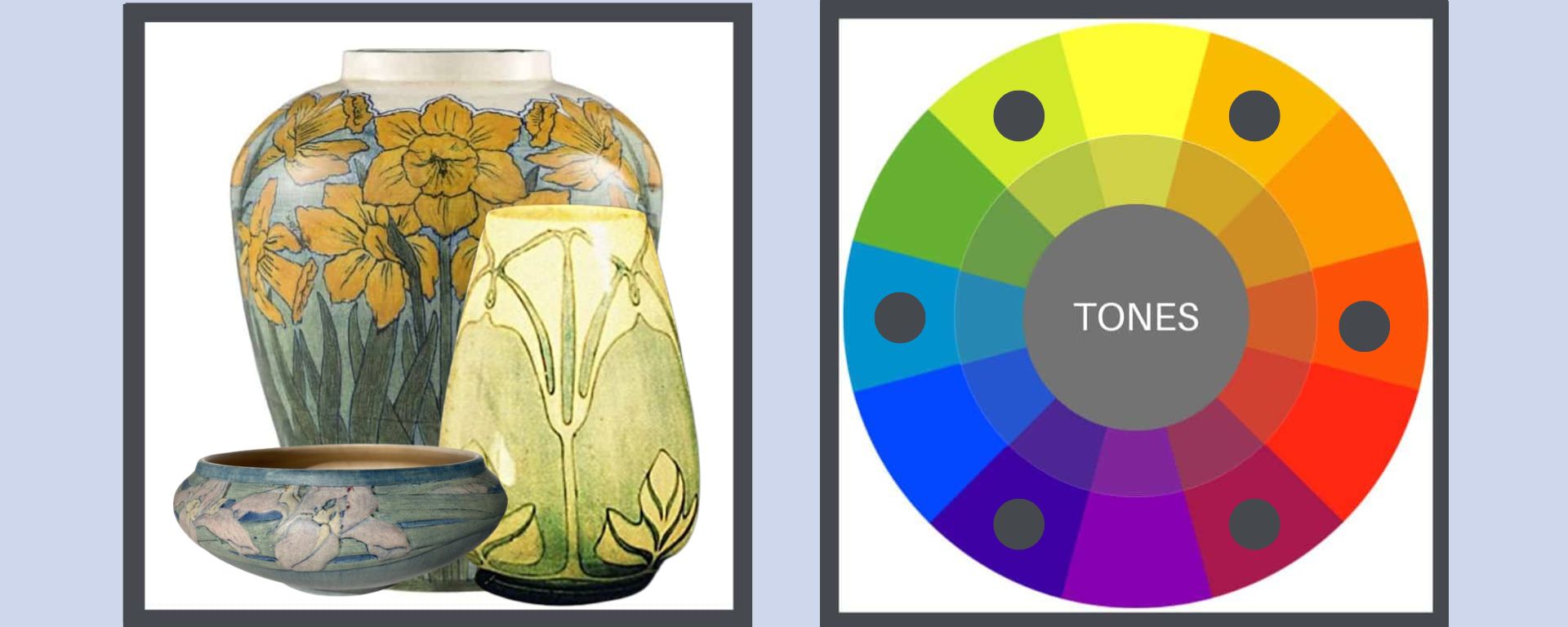
They deliver the same message, from a different, equally harmonious voice. Trend alert! Notice that they too are tertiary colors, toned by black & white.
American Arts & Crafts pottery produced from 1895 to 1940, they were thrown by hand (by men) & decorated (by women), each one unique. They were all required to be functional, as dinnerware or vases, but the aesthetic aspects of nature & fine craftsmanship were regarded as highly important. Each piece was formed of local clay & their subject matter reflected the natural world around them. And there is no doubt that they are enchantingly beautiful.
WHAT ABOUT BLUE?
 Blue is a found in the A&C palette, as seen in the Seroco palette (Pure Blue.) It is a color often used in pottery. It’s the color of the sky & you’d be hard-pressed to find something more natural than the sky. It complements brick beautifully, as well as off-white & greens. I have paired it here with a slight off-white & think it quite handsome!
Blue is a found in the A&C palette, as seen in the Seroco palette (Pure Blue.) It is a color often used in pottery. It’s the color of the sky & you’d be hard-pressed to find something more natural than the sky. It complements brick beautifully, as well as off-white & greens. I have paired it here with a slight off-white & think it quite handsome!
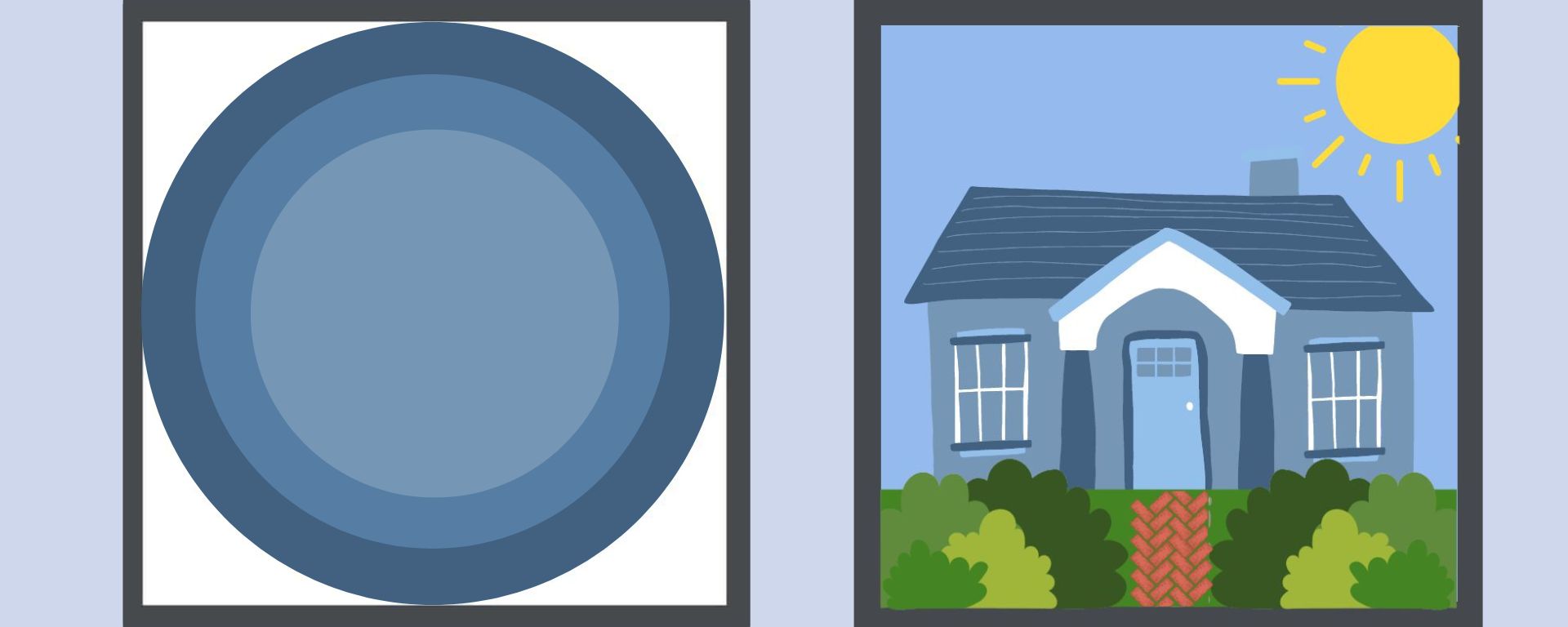
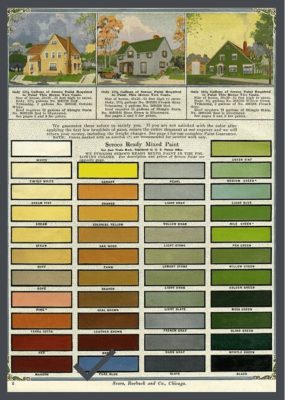
Jane Powell’s BUNGALOW:The Ultimate Arts & Crafts Home (page 70) shows a very cool Gothic Revival in Denver that is painted 2 shades of blue. In my mind’s eye there’s another blue one, I believe in Portand, but I’m failing to locate it. Dang!
I would paint an A&C house blue.
I’M GOING TO GO YOU ONE CRAZIER
“The happiest omen for a New Year is first Mount Fuji, then the falcon, & lastly eggplant.”
-A famous Japanese proverb
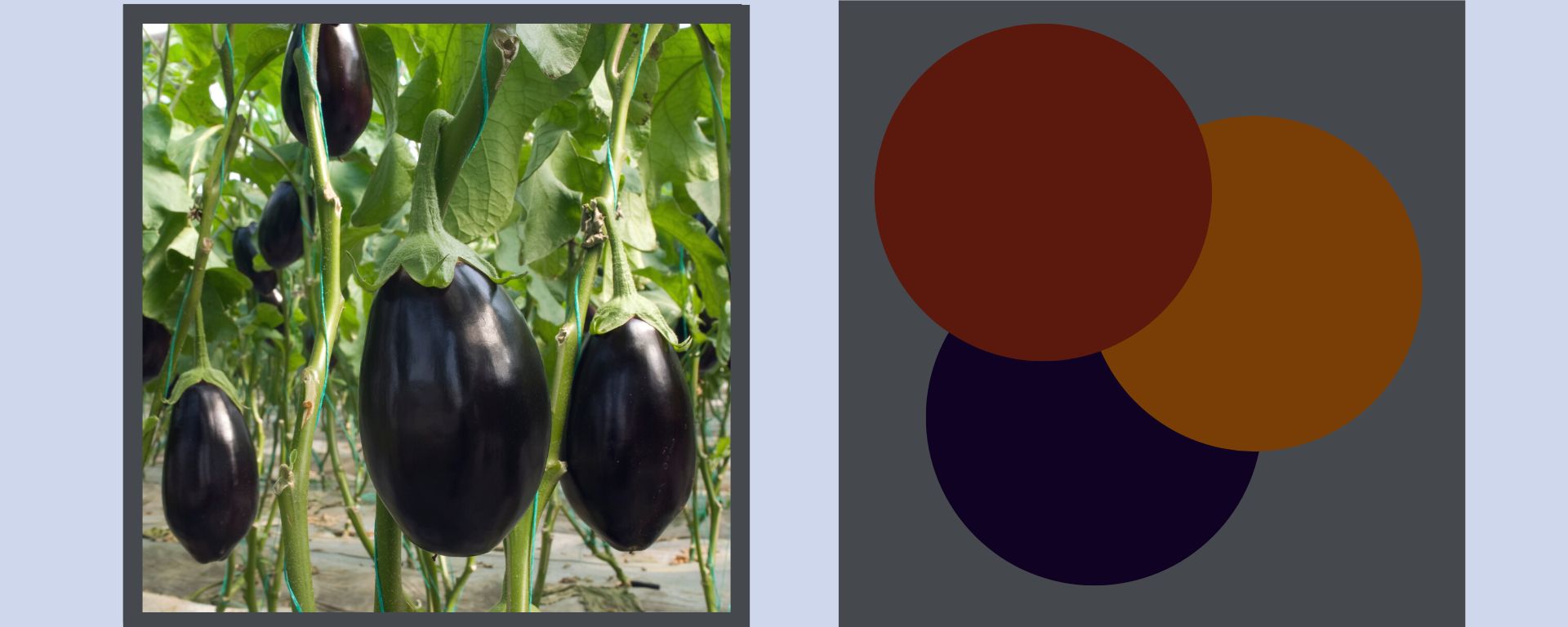
One of my favorite bungalow colors is eggplant. Allow me to ‘splain.
Firstly, purple was my favorite color for many years. It was Jane Powell’s favorite color & she drove a purple P.T. Cruiser. (Mine was red.)
Solanum melongena, eggplant, aubergine, bringal (India) is a member of the Nightshade family, Solanaceae. At one time, it was believed to be highly poisonous & indeed, if consumed in large quantities, its flowers & leaves are toxic.
Jane always felt that anything was permissible with a good backstory. Here’s mine. The colors of the A&C palette were inspired by nature. To be inspired by something, you need to see it, hear it, smell it, etc. However, eggplant was difficult to grow in England. It likes warmer, sunnier climates so its fruit is reluctant to ripen even in warmer areas. Being considered poisonous, why would you waste valuable greenhouse space? So, nobody saw it to be inspired by it because in my heart-of-hearts, I believe they would have been.
But 100 years later, I saw an eggplant & I feel that its color conveys the Arts & Crafts message clearly & beautifully. Combined with pumpkin & deep gold, as an accent, it creates a lovely, natural palette. Have I seen it on any paint cards? No. Do I care? No again.
One of the reasons that I always recommend Ben Moore paints is because they honor the colors of the Movement by producing a high quality paint that stays looking like it was applied yesterday for years. On their website, you can upload a photo of your house & see how the colors of the master potters might be utilized. I also love them because they support preservation, partnering with the National Trust to preserve our built heritage.
SO WHAT DOES THE ARTS & CRAFTS MESSAGE HAVE TO DO WITH MY BUNGALOW’S COLORS?
If I have not completely blown my credibility, I invite you to continue on to the next section which covers historic paints, their formulations & their resulting palettes. Developments in chemistry allow colors to be created & the materials that were used 100 years ago were different from what they are now.
Let’s take a look at why Highlighter Yellow might not enhance your bungalow, even as an accent color!
LEAP ON OVER TO PART 4, IT’S ALL ABOUT THE CHEMISTRY HERE.
 STAY IN THE BUNGALOW KNOW!!!
STAY IN THE BUNGALOW KNOW!!!
Sign up for our newsletter & receive our FREE E-book, 7 VITAL Things to Do Before You Hire a Contractor.
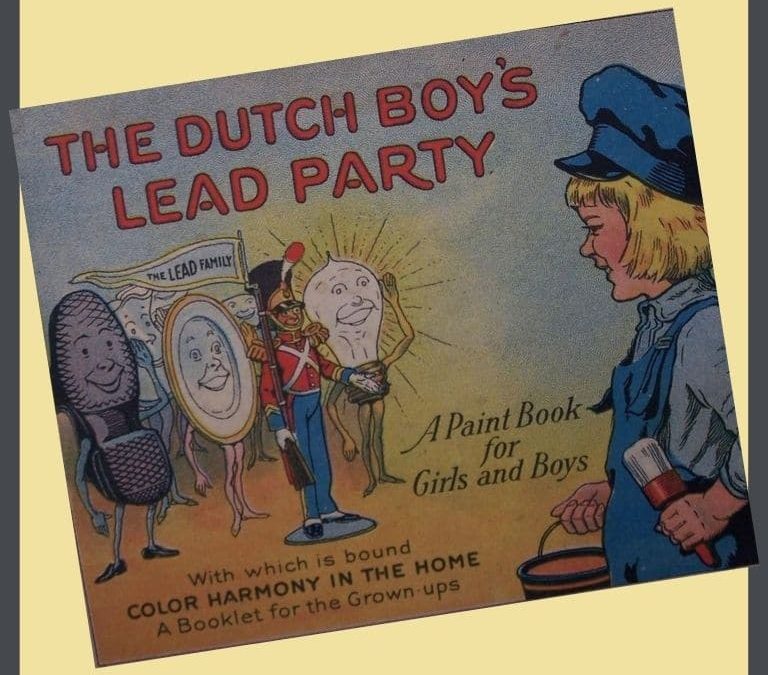
by bungalow101 | May 22, 2022 | Paint
IT’S ALL ABOUT THE CHEMISTRY- LEAD PAINT IN BUNGALOWS
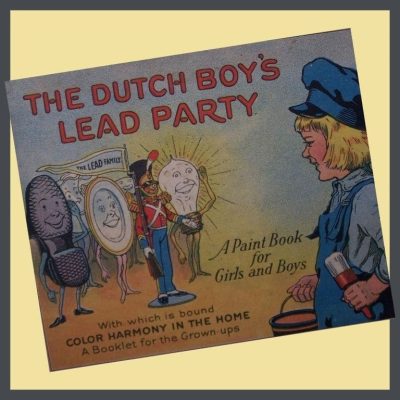 Yes, there is lead paint in bungalows. Let’s understand it & learn how to deal with it, better.
Yes, there is lead paint in bungalows. Let’s understand it & learn how to deal with it, better.
White lead, produced by corroding lead with vinegar, was used in historic paints to produce opacity thereby preventing the sun’s damaging rays from hitting the surface of the substrate. In addition, it was employed to decrease drying time & to increase durability. White lead also helped prevent the growth of mold & mildew.
In the early 1900’s, an effective substitute, titanium dioxide was developed & patented, but, the lead industry continued to mine & recommend lead, so we have lead on the walls of in our old houses & in our plumbing pipes. I have no children, so I am everybody’s mother. It hurts my heart to think of the children whose potential was & is still being diminished by their exposure to lead paint. (It’s my blog & I’ll cry if I want to.)
This charming little booklet, published in 1923, features the Dutch Boy on the cover, talking to the lead soldier. Inside there are 14 images of items that use lead such as a light bulb (lead glass), shoes & baseballs (lead in the rubber), & a bullet which we know is made of lead. A “Color Harmony in the Home” booklet is attached for adults. This coloring book for children was part of a campaign by the lead industry, portraying lead as a healthful element, necessary for a happy life.
The hideous truth is that lead’s toxicity was recognized & recorded as early as 2000 BC. Historians believe that the high exposure to lead, heavily used as a preservative, was a contributing force to the decline of the Roman Empire. In Germany, 1696, a decree was issued forbidding the use of lead-based additives in any wine product. The punishment for anyone who was discovered to have added it was death!
1763 Benjamin Franklin wrote about the “dry gripes” (colic) and “dangles” (wrist drop) which affected painters, typesetters & tinkers, who went from house to house repairing household items made of metal. You can read his letter to a friend, both horrible & fascinating, about the ill effects of lead that he had observed, here.
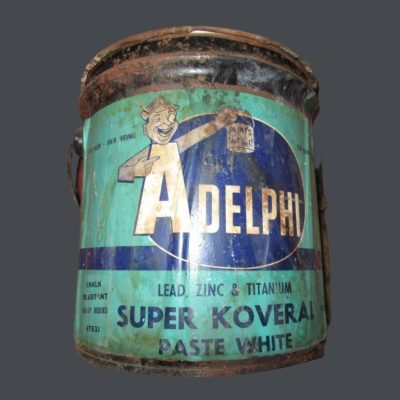 In “Star of the East,” Charles Dickens, an astute observer of the damaging effects of the Industrial Revolution, wrote about the terrible results of lead poisoning on the poor women who worked in London’s white lead mills. “Her brain is coming out her ear & it hurts her dreadful…”.
In “Star of the East,” Charles Dickens, an astute observer of the damaging effects of the Industrial Revolution, wrote about the terrible results of lead poisoning on the poor women who worked in London’s white lead mills. “Her brain is coming out her ear & it hurts her dreadful…”.
In the 18th, 19th & 20th centuries it was well known that to work in an industry where you handled lead was going to make you sick or even kill you. However, here in the United States, the lead industry fought fiercely to quiet, even intimidate, researchers & doctors who reported on or identified lead as a hazard. In 1867, the first prepared or “ready mixed” paints in the United States, were developed, spreading the lead danger to the people who worked in the paint plants, & on their dusty work clothes, to their families at home.
Lead was banned from house paint in Australia in 1914. That same year, childhood lead poisoning was first reported in America. However, lead wasn’t banned for use in paint in America until1978, a full generation later. And that’s why there’s lead paint in bungalows. Gack!
WHY AM I TELLING YOU ABOUT LEAD PAINT IN BUNGALOWS?
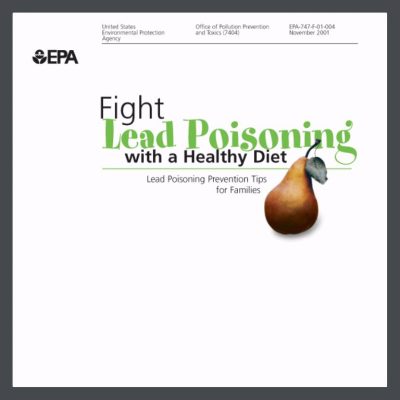 Because the first people that I ever knew to renovate an old house had a baby. Mom was pregnant during the work & when she delivered, it was tragic. I am not going to describe the situation to you any more than this, but it affected me profoundly. The baby was tested for heavy metals & she was off the charts for lead.
Because the first people that I ever knew to renovate an old house had a baby. Mom was pregnant during the work & when she delivered, it was tragic. I am not going to describe the situation to you any more than this, but it affected me profoundly. The baby was tested for heavy metals & she was off the charts for lead.
Many of you will be hiring painters. Lead paint disturbance is highly regulated by the EPA, but it is also highly disregarded as a hazard, because some people don’t care about mothers & babies & mitigation can drive costs up. I urge you to be willing to pay the higher expense of hiring a painter who does care about mothers & babies, & is certified (by the EPA) to test for & handle lead. The EPA lead booklet, Renovate Right, which will provide guidance for you can be found here.
Another EPA booklet, Fight Lead Poisoning with a Healthy Diet explains how you can help your children by providing them with good nutrition. It tells you to keep them well fed because children with empty tummies absorb more lead than children with full ones. It advises you to serve foods rich in iron, calcium & Vitamin C which can help protect children from lead poisoning. It provides lists of foods with these nutrients.
THE EPA also offers recommendations for lead test kits. There are techniques & tools that can be used in handling lead. If you live in a house built before 1978, you should assume that you have some lead paint in your house. You might want to perform lead testing in your bungalow.
If you use a pro to paint, I am suggesting strongly that whomever you hire is trained & certified by the EPA to perform lead testing. They will give you a copy of Renovate Right.
WHAT IS PAINT?
Pigment, Binder & Vehicle
Paint is a dispersion, a mixture in which fine particles of one substance are scattered throughout another substance. It contains small solid particles, usually crystalline, (describing a substance in which the constituent atoms, molecules, or ions are arranged in a regular, repeating three-dimensional pattern) in a liquid medium. When it is applied to a surface, it dries to a solid, protective film, which enhances the beauty of the object to which it is applied.
Pigment
The pigment is the part that we usually care about the most- the color. However, it also has the job of making the paint opaque, blocking ultraviolet light, which causes deterioration to the substrate (an underlying layer or substance.) You have seen old buildings covered in flaking paint whose wood is clearly dried & deteriorating. It’s not protected.
Coloring pigments were also added. Originally, these colors were from natural sources but expanded in range & materials as chemists created more hues.
Binder
For oil-based paints, linseed oil, a colorless to yellowish oil obtained from the dried, ripened seeds of the flax plant (Linum usitatissimum), was frequently chosen because it is a drying oil. It causes the paint to darken over time, which is why Jane Powell always hollered about the use of white-white paint. It’s just not a historic possibility!
Vehicle
The fluid component was termed the vehicle, or medium, because it carried the pigment. Historically, vehicles included turpentine in oil paints. Linseed oil paint was often thinned with an organic solvent, such as turpentine for easier spreading & the enhancing of its drying speed.
Recently, people have become more generally aware of the dangers that these chemical pose. We use latex paints which, while they may not contain lead, release fumes containing a variety of chemicals, some of which may have short- & long-term adverse health effects as they dry & cure which can take some weeks. The fumes are produced by Volatile (easily evaporated at normal temperatures) Organic Compounds (organic compounds are generally any chemical compounds that contain carbon-hydrogen bonds.)
MORE THAN JUST LEAD IN BUNGALOW PAINTS
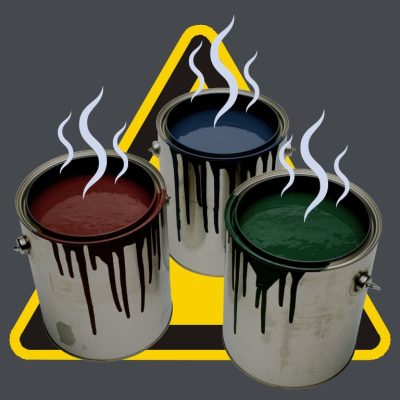 Modern paints are far more complex chemically than early paints. Additional ingredients have been added to the simple 3-part system of pigment, binder, & vehicle. Different paints have different chemical make-ups. The actual gases depend on the formula of the paint. Usually, the greater heavily tinted & glossy the paint, the more VOCs are released.
Modern paints are far more complex chemically than early paints. Additional ingredients have been added to the simple 3-part system of pigment, binder, & vehicle. Different paints have different chemical make-ups. The actual gases depend on the formula of the paint. Usually, the greater heavily tinted & glossy the paint, the more VOCs are released.
Be aware that even today, there are other chemicals in paint that are hazardous. Make sure that you follow all the safety instructions- PPE, ventilation, clean-up & disposal- that are suggested by the manufacturer. Here’s an article on how to read a Safety Data Sheet. Encourage your painter to do the same. Yes, he may grumble, but if he hears it enough, he just might listen. Here are some videos that will provide you with an orientation to the use of PPE as suggested in the Safety Data Sheet.
There are low & no-VOC options & more are being formulated all the time because of public demand. In the future, I’m going to post a blog about how to read a Safety Data Sheet. I wish like heck that I could type faster!
LET’S HEAD ON OVER TO PART 5, HISTORIC PAINT COLORS HERE.
 STAY IN THE BUNGALOW KNOW!!!
STAY IN THE BUNGALOW KNOW!!!
Sign up for our newsletter & receive our FREE E-book, 7 VITAL Things to Do Before You Hire a Contractor.
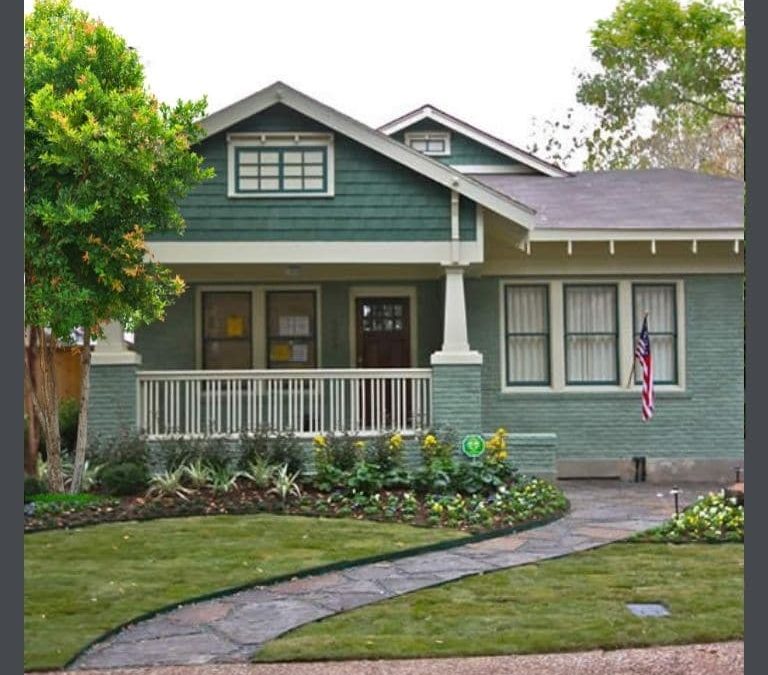
by bungalow101 | May 21, 2022 | Paint
LET’S LOOK AT SOME BUNGALOWS!
Photo credit Robert Schweitzer, BUNGALOW COLORS: EXTERIORS
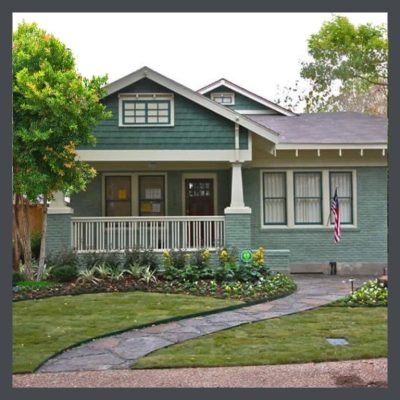 Now that I’ve thoroughly destroyed all possible affinity for the paint purveyors of the past, let’s look at some bungalows & see what combinations these paint companies offered. We all know about Sears kit houses-prefabricated homes that were delivered by train all ready to assemble on site, but Sears also offered their own line of paints, Seroco, which you could purchase alone, or use to make your kit house your very own.
Now that I’ve thoroughly destroyed all possible affinity for the paint purveyors of the past, let’s look at some bungalows & see what combinations these paint companies offered. We all know about Sears kit houses-prefabricated homes that were delivered by train all ready to assemble on site, but Sears also offered their own line of paints, Seroco, which you could purchase alone, or use to make your kit house your very own.
Below is a catalogue from 1914. An inside pages shows the colors that were offered. There is nothing wrong with the colors presented by modern day paint companies. I greatly appreciate that they have researched & formulated these very beautiful palettes, however, they are very restricted.There were many paint companies selling paint at the turn of the century & they all adjusted their palettes to some extent, with the new A&C trend. (At the end of the page I’ll show you a few.)
I often hear people complaining that they don’t like the A&C palette, but they just haven’t seen the possibilities. I’m pretty tired of the usual historic palettes too.
Though earlier illustrations in Seroco catalogs show & specify colors, this changed soon after they began offering the paints. Sears architectural catalogs, in black & white, depict only lighter and darker parts. Of course photos of bungalows from the time show only black & white. So, what do we use as a guide? The palette I’m going to display to you reflects the full spectrum of the colors that deliver the Arts & Crafts message– the belief in craftsmanship which stresses the inherent beauty of the material, the importance of nature as inspiration, & the value of simplicity, utility, & beauty.
 LET’S LOOK AT SOME BUNGALOWS-JUST FOOLIN’ AROUND
LET’S LOOK AT SOME BUNGALOWS-JUST FOOLIN’ AROUND
I decided to take a look at our various standard color harmonies to see how the colors play out on a “real” house, using historic Seroco colors. I’m using the top of the color wheel for all these examples. Tip it, & there are more choices still.
ANALOGOUS BUNGALOWS
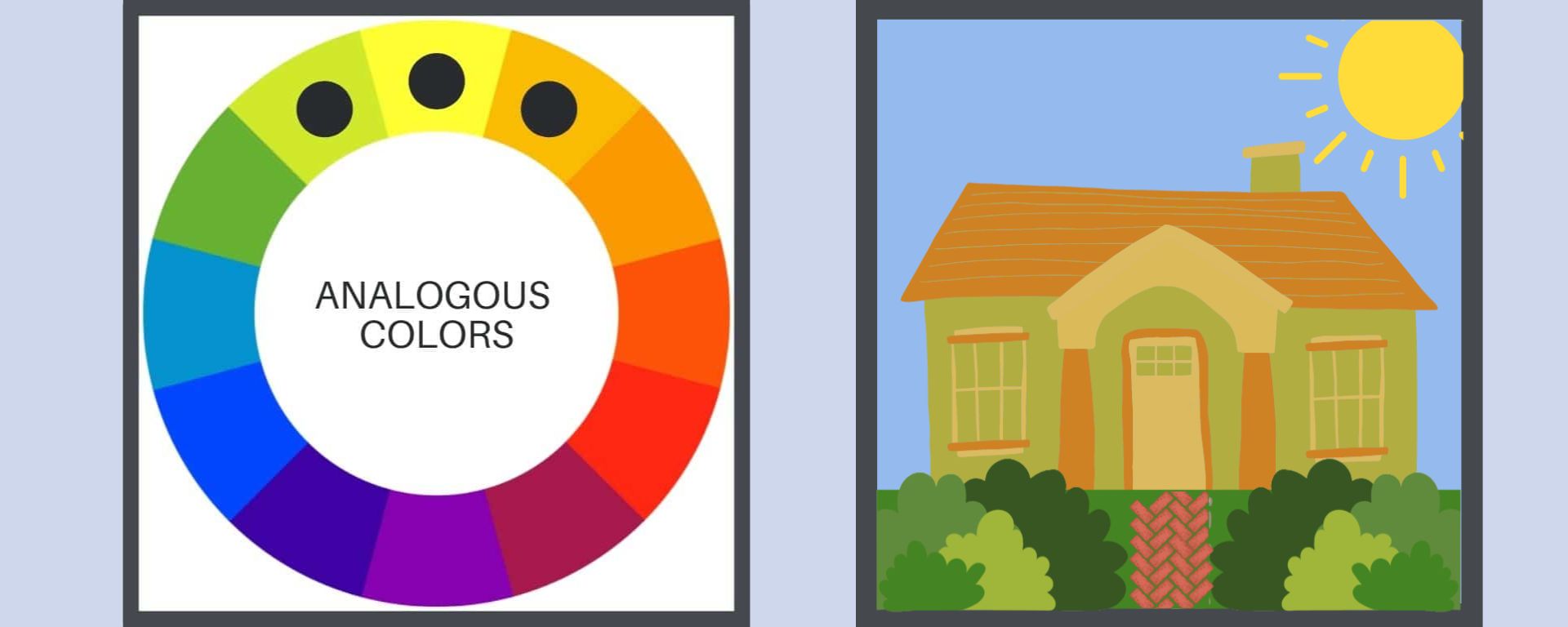
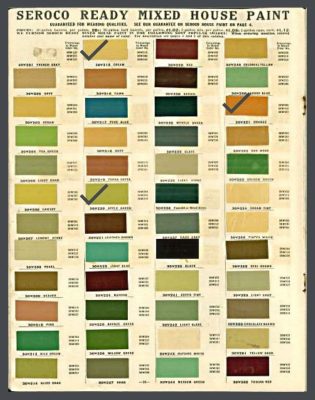
I really like it! I have put little check marks on the paint sample board beside the colors that are closest to the pure colors shown on the color wheel.
The benefit of analogous tones is that they are a smooth transition from one to the next. These colors allow a great deal of wiggle room in regard to where you use each one, because they are so closely related. In coolor climates, perhaps lead with the darker ones & in warmer, lead with the lighter. I think that if you were to choose an analogous palette, you’d have a beautiful bungalow!
COMPLEMENTARY BUNGALOWS
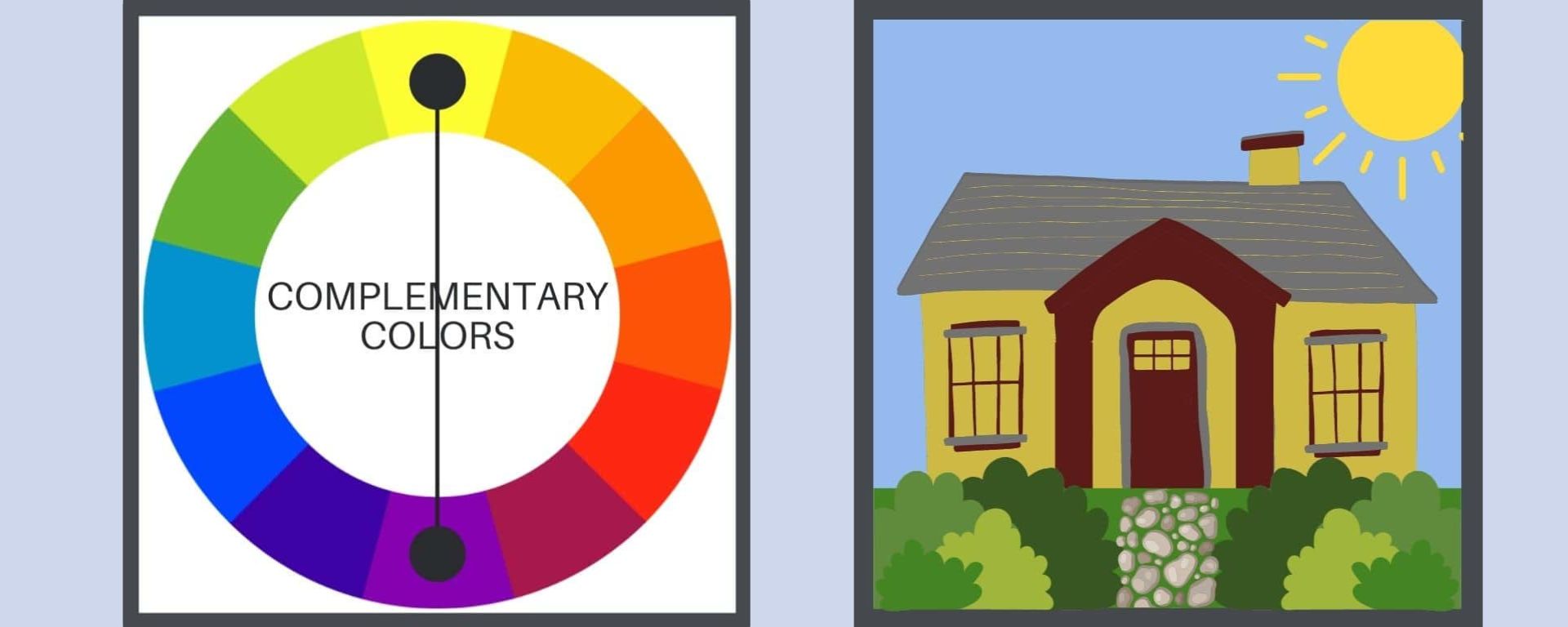
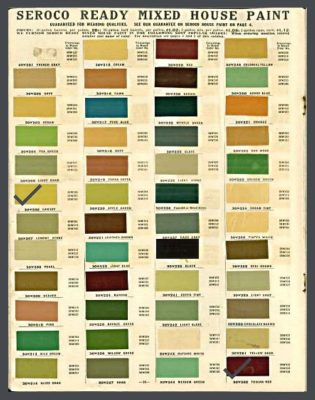
I would never have considered pairing these 2 colors, the closest that Seroco offers me to the pure colors of the color wheel, & I love them on a bungalow! They could be used with a gray roof to amplify the cooler tone of the red & add gray as the 3rd paint color (which my graphics program has thoughtfully done here.) or you could choose a monotone (lighter or darker) of the gold for your 3rd, with maybe a black roof & accents. Or a brown or red roof to go warm. It’s a good base combination on which you could build a harmonious palette in cool or warm tones.
MONOCHROMATIC BUNGALOWS
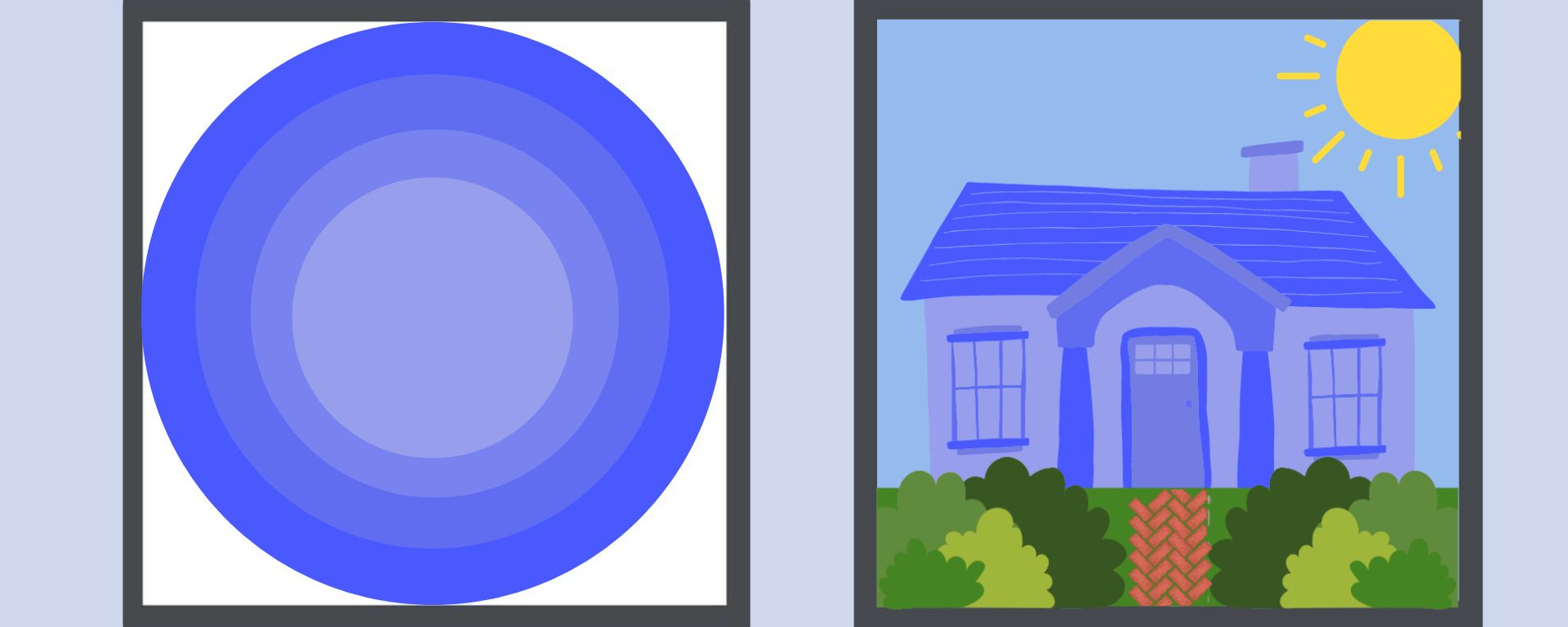

This is a color combination on which you could bet money! Monochromatic tones are always a sure winner because there’s great harmony in repetition. The combo allows you to use your roof as a contrasting color, your landscaping or your hardscaping. You do not risk ending up with a hodgepodge. All it takes it one contrasting element to create interest. I would suggest a neutral or a complementary color for maximum pop.
Should you lack much confidence when it comes to color, this is the choice for you. You can use it to make your voice heard without feeling like you are shouting.
TETRADIC BUNGALOWS
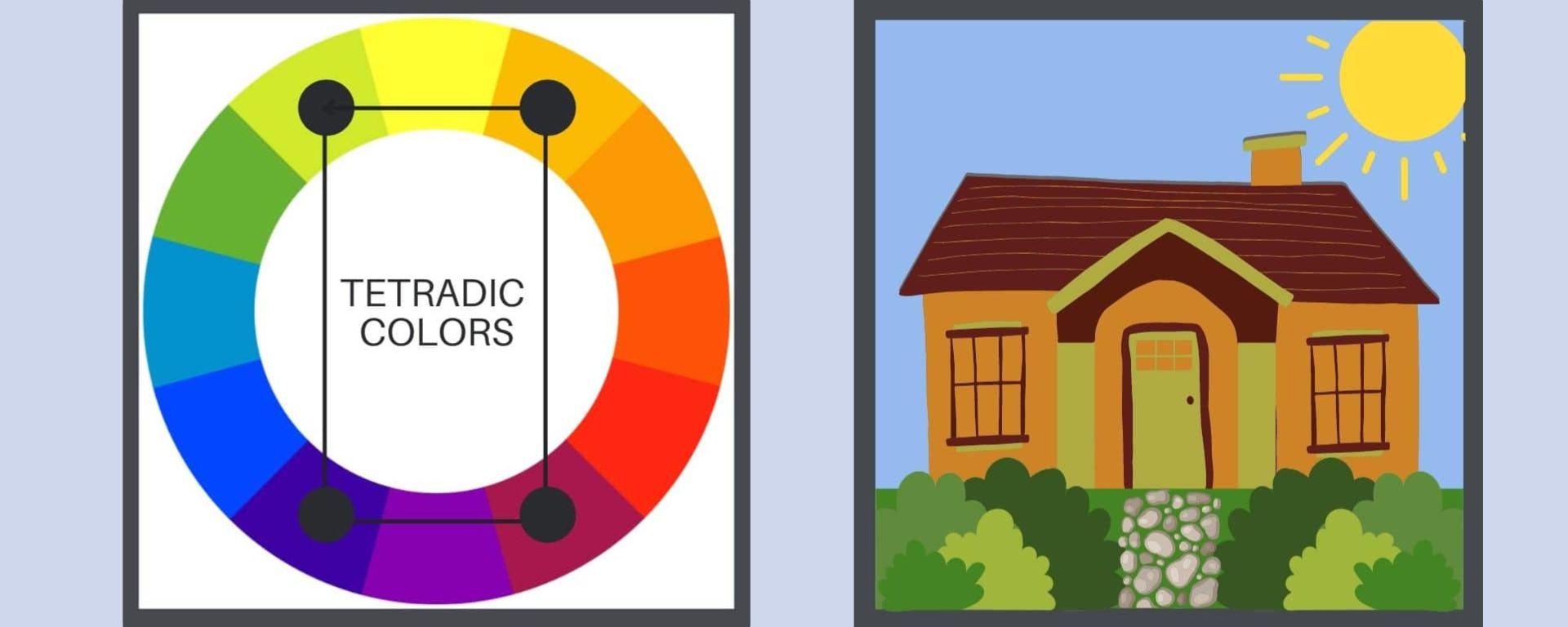
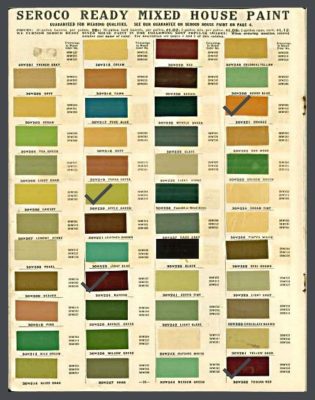
Another eye-pleasing combination, in this area of the color wheel, & one not commonly used. A large variety of color proportions work in this palette. Because of my lack of choices on the Seroco color sheet, I have used only one red. If you want to lighten the green & the pumpkin, that’s fine too. Once again, you could go warm or cool with your roof, path & flowers.
TRIADIC BUNGALOWS
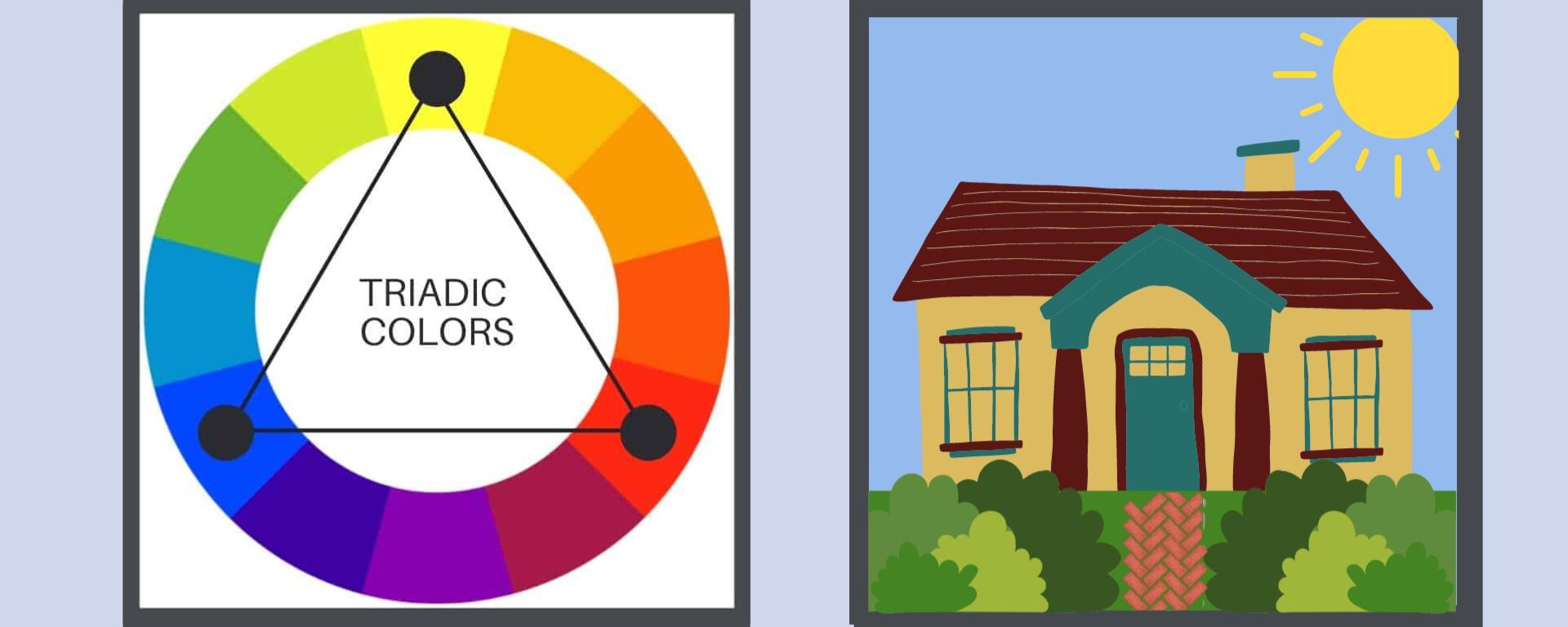
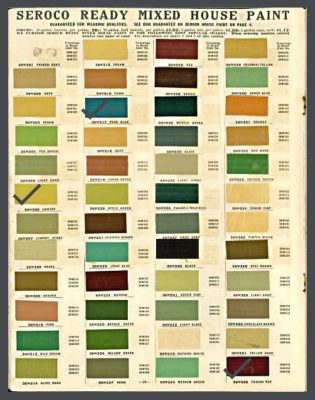
So here’s the bungalow/Seroco version of the primary colors- yellow, red & blue. Even in these muted tones, this combination is quite lively. Maybe not baby blocks lively, but lively nonetheless, & again offering warm & cool choices for roofing & landscaping.
LET’S LOOK AT SOME BUNGALOW PAINT SAMPLES BEYOND SEARS
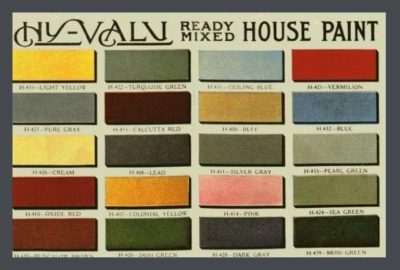
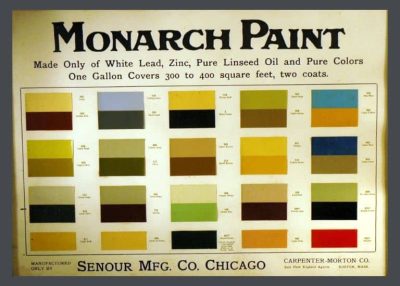
LET’S APPLY ALL THIS INFORMATION TO YOU & YOUR BUNGALOW IN PART 6, HERE.
 STAY IN THE BUNGALOW KNOW!!!
STAY IN THE BUNGALOW KNOW!!!
Sign up for our newsletter & receive our FREE E-book, 7 VITAL Things to Do Before You Hire a Contractor.

by bungalow101 | May 20, 2022 | Paint
YOUR BUNGALOW COLORS EXTERIOR CHECKLIST
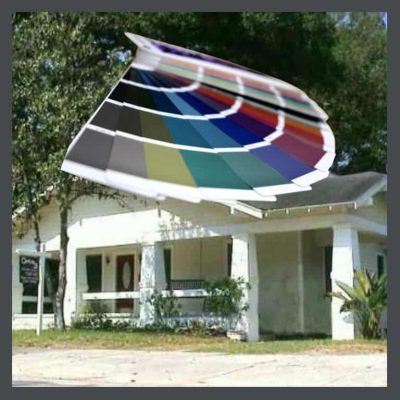 It’s time to make some big decisions & there are so many choices, so use this bungalow colors exterior checklist to put yourself on the right path.
It’s time to make some big decisions & there are so many choices, so use this bungalow colors exterior checklist to put yourself on the right path.
I have seen people spend months agonizing over their many choices only to finally choose & be disappointed. I have driven by bungalows whose colors perplex me & I wonder how the homeowner feels about them.
So, now that you know:
A. How colors work
&
B. The philosophy behind the design of your house, let’s figure out how to blend these with your own voice to create a harmonious color scheme for your home. I’m a checklist person. At any particular moment in time, I’ve my paw in many pots. To keep myself on a linear path instead of whirling in circles, mapping out my steps in their proper sequence increases my efficiency. I love the sensation of making check marks by the DONEs!
HERE’S MY EASY-PEASY BUNGALOW COLORS EXTERIOR CHECKLIST
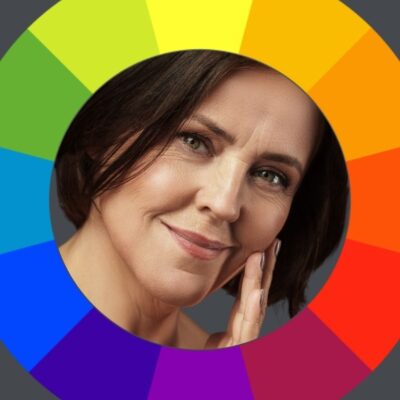 1. Ideally, the inside & outside of your house should harmonize- conveying the same message in a coordinated voice. Let’s start with focusing on the message. (I’m assuming that if you have made it thus far, you have somewhat of an interest in the Arts & Crafts Movement.) What do you want your house to express to the world? I’m an artist; I love gardening; I’m a mother. What do you want it to say to you? Let’s start with that.
1. Ideally, the inside & outside of your house should harmonize- conveying the same message in a coordinated voice. Let’s start with focusing on the message. (I’m assuming that if you have made it thus far, you have somewhat of an interest in the Arts & Crafts Movement.) What do you want your house to express to the world? I’m an artist; I love gardening; I’m a mother. What do you want it to say to you? Let’s start with that.
2. How do you want your house to serve you? Is it a place of refuge where you come to heal from your battering day in the workplace or in the world? When I was battling Walgreens in our fight to save an important historic building in our town, coming home from a day of petition signings or town meetings, the details of my beautiful house were a healing distraction.
Or, is it a fueling station where you get rejuvenated for the next day? Or, both????
3. Do you work from home? Do you want your house to energize you when you hit that 4 o’clock slump?
4. Do you lead a more casual or a more formal lifestyle? When you throw a party, do your guests chat over ginger tea & gluten free cookies, beer & pretzels, or juice boxes & chicken nuggets?
5. Consider your own color preferences. What colors do you like to wear? What colors draw your eye? Which ones brighten your mood? Take a look at the colors & color groups presented in parts 1, 2 & 3. Consider your reactions to them.
6. How much sun does the front of your house receive during various parts of the day? Does it have overhanging eaves? What direction does it face?
7. Do you want your house to recede, with darker colors or to move forward?
8. How about your landscaping? If you have flowering plants, do they tend toward warm or cool colors?
9. What are the colors of the houses near you? You don’t want to choose a color that is not harmonious of too much the same. Of course, your neighbors could get inspired by you &…
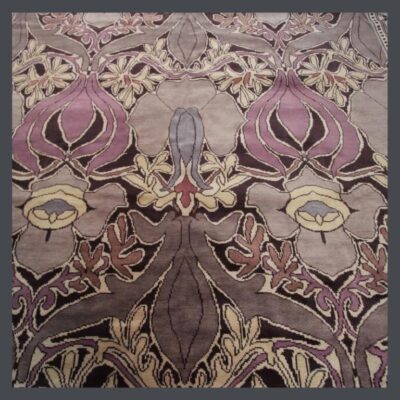 10. Stepping back inside, do you have textiles that you plan to use- draperies, rugs, upholstery? It is always good to have a starting point & the colors that you are using inside your house can be a great guide. I have a rug that guided me in choosing the colors for my Tampa house. (Sorry I haven’t included an image of it for you to see but we keep the rug in storage because my cat has tummy issues.)
10. Stepping back inside, do you have textiles that you plan to use- draperies, rugs, upholstery? It is always good to have a starting point & the colors that you are using inside your house can be a great guide. I have a rug that guided me in choosing the colors for my Tampa house. (Sorry I haven’t included an image of it for you to see but we keep the rug in storage because my cat has tummy issues.)
11. How about, artwork, pottery & other collections. They are a wonderful inspiration for your palette. They are the things that you love.
12. What are the tastes of your significant other? You might not be the only one who lives in your home & you want your partner to be happy & sweet-tempered.
It’s an interesting phenomenon in my household, that we always work it out in the end. We may start out with completely divergent favorites, but if we persist, & continue looking & searching, we are both always thrilled by our final choice. So, just keep talking.
THE PURPOSE OF THE CHECKLIST
This is not a list to just skim through.
Yeah, YOU! Put down the paintbrush & pick up a pen. Above is a list of things to examine before you even consider hitting the paint store. Painting the exterior of a house is a huge commitment. Truly huge. It’s not a paint chip or paint sample, it’s many square feet of expensive color.
 STAY IN THE BUNGALOW KNOW!!!
STAY IN THE BUNGALOW KNOW!!!
Sign up for our newsletter & receive our FREE E-book, 7 VITAL Things to Do Before You Hire a Contractor.

by bungalow101 | May 17, 2022 | Features
 I’m a gardener & a bungalow style custom shed for me was a much needed item. I love to buy pots, tools & soil supplements & I needed a place to stash the dang stuff. With only a porte cochere & lacking a garage, a shed was also required to store my husband’s items- hardware, tools & of course, the bar-be-que.
I’m a gardener & a bungalow style custom shed for me was a much needed item. I love to buy pots, tools & soil supplements & I needed a place to stash the dang stuff. With only a porte cochere & lacking a garage, a shed was also required to store my husband’s items- hardware, tools & of course, the bar-be-que.
I’m also a big fan of tiny houses, so I wanted it to look like the wee folk could live there in comfort. And, it had to be lovely. It’s plunk in the middle of my backyard so it needed to complement the plants & ideally, mimic my bungalow.
It had taken me a year to choose my exterior colors & I was in love with my clipped gable & really wanted to see those again.
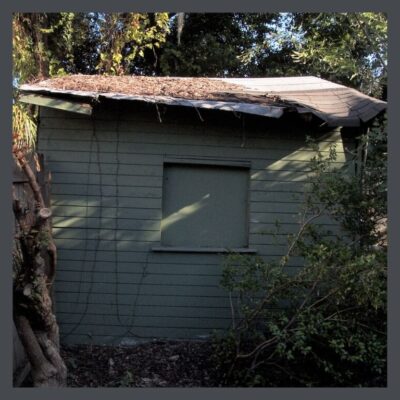 When I purchased my 1925 bungalow, it had a funky old shed that totally creeped me out to enter. In Florida, things get critter filled & really disgusting. As a gardener, I had to go in it often to access my supplies. Ick!
When I purchased my 1925 bungalow, it had a funky old shed that totally creeped me out to enter. In Florida, things get critter filled & really disgusting. As a gardener, I had to go in it often to access my supplies. Ick!
I decided that I needed something nicer, so I started pricing pre-built sheds. They were expensive, not historic & UGLY. So, I decided to go custom & I had some plans drawn by my friend, Tampa architect, Alan Dobbs, for a shed & got some prices for all the trades I would need- carpenter, roofer, painter- for a tiny shed! It all added up to too much plus, I had just completed the restoration of a 1907 Victorian that was in terrible shape & I sorely needed a rest from herding tradespeople & breathing sawdust.
MASTERS OF THE CUSTOM BUNGALOW SHED
I called Historic Shed & was happily surprised at the price they quoted for everything! Because of their great reputation, I even let them pick the hardware & design the doors. I never let anybody choose anything for me but I was tired of making choices. I was thrilled with the doors & the wonderful hinges they brought.
The best part was that it was installed in just over a day. They custom built it in their workshop & then hauled to my backyard, completed & even painted. I am sure that it would have taken a month-long project with all the trade coordinating that I would have had to have done.
I then had a shed that is the mini-me version of my beautiful bungalow. It holds everything I could need & it is clean & fresh. It made another season of gardening quite appealing!
The new custom shed incorporates the color, siding and trim details, roof-line, and outriggers of the bungalow while adding traditional elements such as the bead-board carriage house style doors. At 12’x12′, the storage shed did not require a permit for construction, but did have to undergo design approval by the City of Tampa historic preservation staff. They loved it!
Truth is, I’d like to live in it. I adore tiny spaces. But, it’s full of stuff, which is why we built it & I guess that I’ll just need to commission a doll house to live out my childhood fantasies with the fairies.
P.S. Historic Shed has moved on & is no longer building sheds, however, you can purchase their plans from Liberty House Plans.
 STAY IN THE BUNGALOW KNOW!!!
STAY IN THE BUNGALOW KNOW!!!
Sign up for our newsletter & receive our FREE E-book, 7 VITAL Things to Do Before You Hire a Contractor.

 Bungalow color harmony begins with being familiar with your home’s long philosophical & aesthetic history. Your beloved bungalow is the offspring of a movement that started in the late 1800’s in England & spread to the United States, primarily through the work & words of Gustav Stickley, a furniture designer & maker as well as a publisher.
Bungalow color harmony begins with being familiar with your home’s long philosophical & aesthetic history. Your beloved bungalow is the offspring of a movement that started in the late 1800’s in England & spread to the United States, primarily through the work & words of Gustav Stickley, a furniture designer & maker as well as a publisher.










 STAY IN THE BUNGALOW KNOW!!!
STAY IN THE BUNGALOW KNOW!!!






 Blue is a found in the A&C palette, as seen in the Seroco palette (Pure Blue.) It is a color often used in pottery. It’s the color of the sky & you’d be hard-pressed to find something more natural than the sky. It complements brick beautifully, as well as off-white & greens. I have paired it here with a slight off-white & think it quite handsome!
Blue is a found in the A&C palette, as seen in the Seroco palette (Pure Blue.) It is a color often used in pottery. It’s the color of the sky & you’d be hard-pressed to find something more natural than the sky. It complements brick beautifully, as well as off-white & greens. I have paired it here with a slight off-white & think it quite handsome!



 Yes, there is lead paint in bungalows. Let’s understand it & learn how to deal with it, better.
Yes, there is lead paint in bungalows. Let’s understand it & learn how to deal with it, better. In “Star of the East,” Charles Dickens, an astute observer of the damaging effects of the Industrial Revolution, wrote about the terrible results of lead poisoning on the poor women who worked in London’s white lead mills. “Her brain is coming out her ear & it hurts her dreadful…”.
In “Star of the East,” Charles Dickens, an astute observer of the damaging effects of the Industrial Revolution, wrote about the terrible results of lead poisoning on the poor women who worked in London’s white lead mills. “Her brain is coming out her ear & it hurts her dreadful…”.
 Modern paints are far more complex chemically than early paints. Additional ingredients have been added to the simple 3-part system of pigment, binder, & vehicle. Different paints have different chemical make-ups. The actual gases depend on the formula of the paint. Usually, the greater heavily tinted & glossy the paint, the more VOCs are released.
Modern paints are far more complex chemically than early paints. Additional ingredients have been added to the simple 3-part system of pigment, binder, & vehicle. Different paints have different chemical make-ups. The actual gases depend on the formula of the paint. Usually, the greater heavily tinted & glossy the paint, the more VOCs are released.
 Now that I’ve thoroughly destroyed all possible affinity for the paint purveyors of the past, let’s look at some bungalows & see what combinations these paint companies offered. We all know about
Now that I’ve thoroughly destroyed all possible affinity for the paint purveyors of the past, let’s look at some bungalows & see what combinations these paint companies offered. We all know about  LET’S LOOK AT SOME BUNGALOWS-JUST FOOLIN’ AROUND
LET’S LOOK AT SOME BUNGALOWS-JUST FOOLIN’ AROUND












 It’s time to make some big decisions & there are so many choices, so use this bungalow colors exterior checklist to put yourself on the right path.
It’s time to make some big decisions & there are so many choices, so use this bungalow colors exterior checklist to put yourself on the right path. 1. Ideally, the inside & outside of your house should harmonize- conveying the same message in a coordinated voice. Let’s start with focusing on the message. (I’m assuming that if you have made it thus far, you have somewhat of an interest in the Arts & Crafts Movement.) What do you want your house to express to the world? I’m an artist; I love gardening; I’m a mother. What do you want it to say to you? Let’s start with that.
1. Ideally, the inside & outside of your house should harmonize- conveying the same message in a coordinated voice. Let’s start with focusing on the message. (I’m assuming that if you have made it thus far, you have somewhat of an interest in the Arts & Crafts Movement.) What do you want your house to express to the world? I’m an artist; I love gardening; I’m a mother. What do you want it to say to you? Let’s start with that. 10. Stepping back inside, do you have textiles that you plan to use- draperies, rugs, upholstery? It is always good to have a starting point & the colors that you are using inside your house can be a great guide. I have a rug that guided me in choosing the colors for my Tampa house. (Sorry I haven’t included an image of it for you to see but we keep the rug in storage because my cat has tummy issues.)
10. Stepping back inside, do you have textiles that you plan to use- draperies, rugs, upholstery? It is always good to have a starting point & the colors that you are using inside your house can be a great guide. I have a rug that guided me in choosing the colors for my Tampa house. (Sorry I haven’t included an image of it for you to see but we keep the rug in storage because my cat has tummy issues.)
 I’m a gardener & a bungalow style custom shed for me was a much needed item. I love to buy pots, tools & soil supplements & I needed a place to stash the dang stuff. With only a porte cochere & lacking a garage, a shed was also required to store my husband’s items- hardware, tools & of course, the bar-be-que.
I’m a gardener & a bungalow style custom shed for me was a much needed item. I love to buy pots, tools & soil supplements & I needed a place to stash the dang stuff. With only a porte cochere & lacking a garage, a shed was also required to store my husband’s items- hardware, tools & of course, the bar-be-que. When I purchased my 1925 bungalow, it had a funky old shed that totally creeped me out to enter. In Florida, things get critter filled & really disgusting. As a gardener, I had to go in it often to access my supplies. Ick!
When I purchased my 1925 bungalow, it had a funky old shed that totally creeped me out to enter. In Florida, things get critter filled & really disgusting. As a gardener, I had to go in it often to access my supplies. Ick!